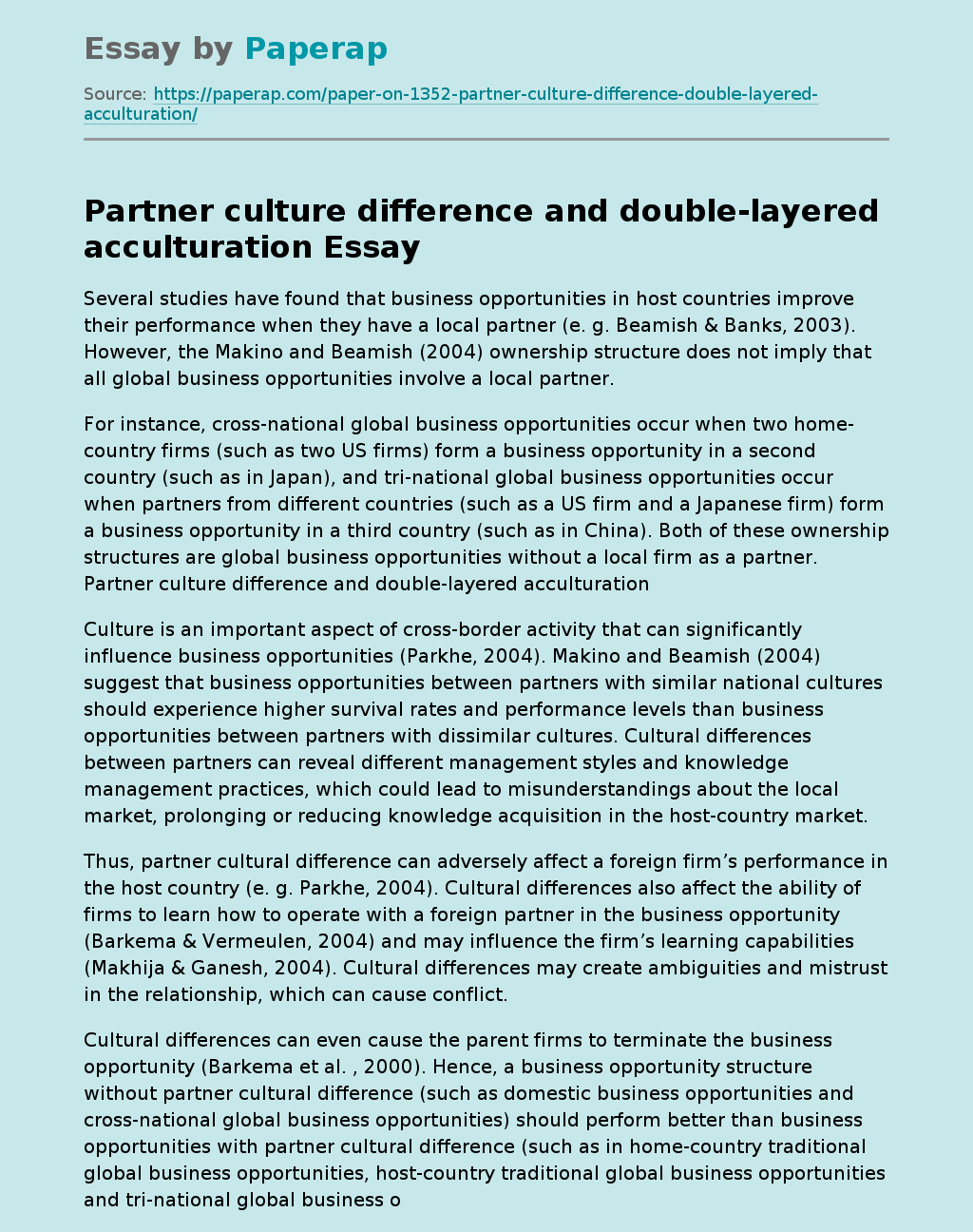Partner Culture Difference and Double-layered Acculturation
Several studies have found that business opportunities in host countries improve their performance when they have a local partner (e. g. Beamish & Banks, 2003). However, the Makino and Beamish (2004) ownership structure does not imply that all global business opportunities involve a local partner.
For instance, cross-national global business opportunities occur when two home-country firms (such as two US firms) form a business opportunity in a second country (such as in Japan), and tri-national global business opportunities occur when partners from different countries (such as a US firm and a Japanese firm) form a business opportunity in a third country (such as in China).
Both of these ownership structures are global business opportunities without a local firm as a partner. Partner culture difference and double-layered acculturation
Culture is an important aspect of cross-border activity that can significantly influence business opportunities (Parkhe, 2004). Makino and Beamish (2004) suggest that business opportunities between partners with similar national cultures should experience higher survival rates and performance levels than business opportunities between partners with dissimilar cultures.
Cultural differences between partners can reveal different management styles and knowledge management practices, which could lead to misunderstandings about the local market, prolonging or reducing knowledge acquisition in the host-country market.
Thus, partner cultural difference can adversely affect a foreign firm’s performance in the host country (e. g. Parkhe, 2004). Cultural differences also affect the ability of firms to learn how to operate with a foreign partner in the business opportunity (Barkema & Vermeulen, 2004) and may influence the firm’s learning capabilities (Makhija & Ganesh, 2004).
Cultural differences may create ambiguities and mistrust in the relationship, which can cause conflict.
Cultural differences can even cause the parent firms to terminate the business opportunity (Barkema et al. , 2000). Hence, a business opportunity structure without partner cultural difference (such as domestic business opportunities and cross-national global business opportunities) should perform better than business opportunities with partner cultural difference (such as in home-country traditional global business opportunities, host-country traditional global business opportunities and tri-national global business organization).
An alternative perspective focuses on double-layered acculturation, which is defined as a structure of global business organization in which there are both partner and location cultural differences. The double-layered acculturation perspective suggests that global business opportunities can face operational challenges from both host country national culture and partner culture differences. Barkema et al. (2000) contend that firms that enter a country by establishing a wholly owned subsidiary or global business organization may incur cultural barriers, but the barriers caused by these two modes of entries may differ.
These authors further assert that culture difference makes a global business organization more susceptible to termination than a wholly owned subsidiary. A wholly owned subsidiary requires that a firm adapt to a national culture Host-country traditional global business opportunities and tri-national global business opportunities, however, incur ‘double-layered acculturation’ by requiring adaptation to both the culture of the partner and the cultures of nations that business opportunities are operating in.
Contractor and Lorange (2003) note that this kind of culture difference gives rise to higher costs for an global business organization Double-layered acculturation leads to higher relational hazards (e. g. trust building costs) for host-country traditional global business opportunities and tri-national global business opportunities than for home-country traditional global business opportunities and cross-national global business opportunities.
As noted above, strategic alliances or partnerships in channels of distribution are not usually legally defined entities governed by state, national, or international laws, and thus trust may be viewed as a substitute for control (Rousseau & Sitkin, 2004). That is, while a legal contract is one way of controlling an exchange partners’ behavior, detailed contracts can get in the way of effective exchange relationships (MacCauley, 2001).
However, relational trust is developed between exchange partners through repeated interactions over time (Rousseau & Sitkin, 2004). As a partner is found to be reliable and dependable, positive expectations are formed regarding the partner’s intentions. Over time, attachments are formed between partners based on reciprocated care and concern (McAllister, 2004). Such trust is critical in strategic alliances among partners because strategic alliances require the coordination of two or more partners to pursue shared objectives (Doz, 2000 and Kanter, 2000).
Partner Culture Difference and Double-layered Acculturation. (2017, May 26). Retrieved from https://paperap.com/paper-on-1352-partner-culture-difference-double-layered-acculturation/

